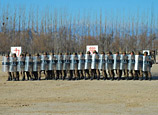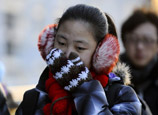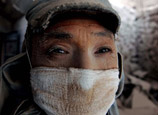
Yangliushan village in Jiaxing, East China's Zhejiang Province, is home to part of China's first nuclear power plant.
The Yangliushan section - unit two of the Qinshan power plant - began operating in 2002.
As China barrels ahead with an ambitious plan to almost double its nuclear power plants over the next several years, residents near China's first nuclear facility have expressed concern over health problems plaguing the village.
The Global Times spoke to a number of residents who live around the reactor who were all worried about possible repercussions if they spoke on the record, and asked to remain anonymous.
In particular, a local village doctor, Cui Qiang (a pseudonym), told the Global Times that cancer rates in the local area are far above the national average. "As far as I can tell, 21 villagers, ranging in age from 18 years old to very old, have cancer now, mostly related to their blood system."
The local village's population stands at 2,053.
Going by the official figure for the population, the cancer rate in the village is about 1 percent, but Cui said he believes the rate is around 2 percent because many villagers have relocated elsewhere.
In comparison, according to official statistics released earlier this month, the country's national cancer rate in 2012 was about 0.285 percent.
Cui said that even though cancer is a problem everywhere, the rate is "too high" in the village.
He believes the nuclear power plant is the cause.
Something stinks?
"I can sometimes smell a strong, pungent odor late at night, and workers at the power plant have told me that they usually put materials into the reactor at that time," Jiang Bo (a pseudonym), a 53-year-old farmer, told the Global Times.
Jiang received a kidney transplant five years ago following kidney failure and recently contracted hepatitis. He said the distance between his home and the Qinshan plant is "only" 400 to 500 meters.
"Some environmental protection experts have come and said my home is way too close (to the plant)," he said, adding that he has lost the ability to do any farm work as he always feels exhausted.
According to a national nuclear power plant environmental safety standard published by the Ministry of Environmental Protection, residents should live at least 500 meters away from a reactor.
It also states that at distances of between 500 meters and 5 kilometers from plants, the number of residents should be restricted.
However, unit two of the Qinshan Power Plant is less than 500 meters from Yangliushan village.
Wang Mei (a pseudonym), a 50-year-old unemployed woman, told the Global Times that she has borrowed more than 200,000 yuan ($31,240) since 2010 for lymphoma-related medical care, and she is now worried about not having any money left for her daughter's college tuition fees.
"So many people are ill now," Wang said, noting that many villagers are sick due to blood-related diseases, which they believe are connected to radiation from the nuclear plant.
Powering ahead
According to a government white paper on energy policy released in October 2012, nuclear power only accounts for 1.8 percent of China's total power output, well below the world average of 14 percent.
By 2015, China is expected to have 41 operating nuclear power units, Zhang Huazhu, chairman of the China Nuclear Energy Association, said in November last year.
"By that time, China will have built nearly 20 extra nuclear power plants," Zhang said.
Zhang was cited in a Xinhua News Agency report as saying that China currently has six nuclear power plants and 15 working nuclear power units.
The 20 extra nuclear power plants are expected to be built in coastal areas, since they are economically developed but far from the country's coal mines, Zhang said.
The ambitious plan to expand China's nuclear power industry is already underway.
Construction started on Rongcheng Shidaowan Nuclear Power Plant, based in Weihai, East China's Shandong Province, on December 21 last year, and the plant is expected to start generating electricity in 2017.
It will represent the latest and biggest nuclear facility in the country, with a total investment of 100 billion yuan provided by the China Huaneng Group, China Nuclear Engineering Group and Tsinghua University.
Electrified debate
The tsunami that hit nuclear power plants in Japan's Fukushima prefecture in 2011, causing the release of radiation, sent political ripples as far north as Beijing, throwing a spanner in the government's plans to massively expand nuclear power in China.
The State Council gave the green light in October 2012 to restart the country's nuclear power program, ending the moratorium on nuclear construction imposed after the Fukushima nuclear disaster.
A State Council report, entitled "the 12th five-year plan on nuclear safety and the prevention of radioactive pollution," which was released in October 2012, highlighted the fact that China has many kinds of nuclear reactors, which poses a problem for safety standards.
The report included a blueprint for nuclear development in China up until 2020, and recommended that older reactors be phased out in favor of newer, safer models.
Official representatives are keen to persuade the public that a Fukushima-style disaster won't happen in China.
Xu Mi, a member of the Chinese Academy of Engineering, was quoted by China Business News as saying in an earlier report that central government departments have been working on safety plans to prevent these kinds of disasters.
He added that the ability to resist natural disasters such as fires, earthquakes and floods would all be incorporated in the planning and design phases of nuclear plants.
However, despite these assurances, residents in Shandong, Zhejiang and Guangdong provinces, where the existing plants are based, told the Global Times that they have doubts as to the safety of the plants, partly because of the Fukushima disaster.
Time will tell what happens to the nuclear industry in China, but as for the residents of Yangliushan, it would seem little will change.
When asked what they plan to do, most simply said: "I have nowhere else to go."
















 Why supervision on 'drug chicken' lacks intensity?
Why supervision on 'drug chicken' lacks intensity?


![]()
